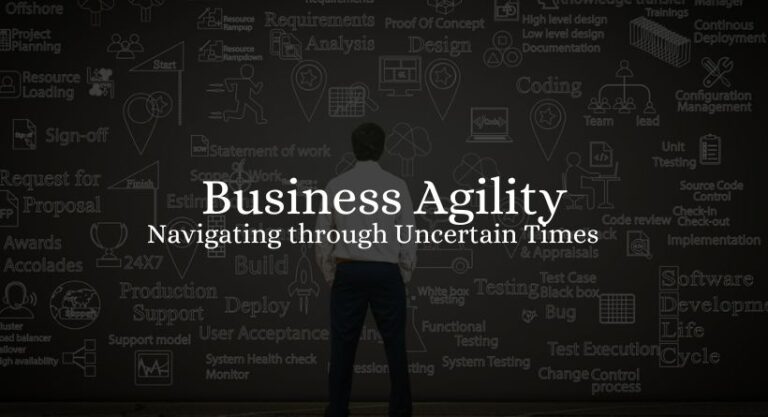In today’s fast-paced and ever-changing business landscape, uncertainty has become the new normal. Industries are constantly evolving, consumer demands are shifting, and unforeseen challenges can arise at any moment. As a result, businesses face the pressing need to adapt and respond swiftly to stay competitive. This is where the concept of business agility comes into play. In this blog post, we will delve into the crucial topic of business agility, its significance, and how it can help organizations navigate through uncertain times.
Acknowledging the challenges that businesses encounter during uncertain times is the first step towards finding effective solutions. The inability to respond swiftly and adapt to changing circumstances can leave companies vulnerable to disruption and hinder their growth potential. The consequences can range from missed opportunities to losing market share, ultimately impacting the overall sustainability of the organization.
Fortunately, there is a solution: business agility. By embracing the principles of business agility, organizations can proactively address the challenges presented by uncertainty. They can transform themselves into nimble entities capable of quickly adjusting their strategies, processes, and operations to seize opportunities and mitigate risks.
In this blog post, we will explore the key aspects of business agility and provide you with actionable insights to help your organization foster agility. We will delve into strategies that empower businesses to anticipate change, respond effectively, and thrive amidst uncertainty. From fostering a culture of adaptability to implementing agile frameworks and leveraging technology, we will equip you with the knowledge and tools needed to navigate through uncertain times successfully.
Imagine a scenario where your competitors swiftly adapt to the changing market conditions while your business struggles to keep up. The consequences can be devastating – loss of customers, eroded market position, and declining revenue. However, by embracing the concept of business agility, you can transform this pain point into a competitive advantage. With the right strategies and mindset, your organization can not only survive but also thrive amidst uncertainty.
Understanding Business Agility
In today’s rapidly evolving business landscape, the concept of business agility has gained significant importance. But what exactly is business agility? At its core, business agility refers to an organization’s ability to adapt, respond, and thrive in the face of uncertainty and change. It is about being flexible, nimble, and proactive rather than reactive.
The significance of business agility becomes even more pronounced in uncertain times. In an era where disruptions and market dynamics can shift overnight, organizations that embrace agility are better positioned to navigate through challenges, seize opportunities, and maintain a competitive edge. They can swiftly adjust their strategies, processes, and operations to align with the changing landscape, ultimately driving growth and long-term success.
Numerous businesses have successfully embraced business agility and reaped its rewards. Take, for instance, Netflix. The streaming giant, originally a DVD-by-mail service, recognized the shifting trends in the entertainment industry and quickly adapted its business model to focus on online streaming. By embracing agility, Netflix not only survived the industry’s transition but also became a dominant force in the digital entertainment space.
Similarly, Amazon has built its empire on a foundation of agility. The company’s relentless focus on customer-centricity and its ability to quickly experiment, iterate, and launch new initiatives have propelled its growth and innovation. Amazon’s continuous adaptations to meet changing customer demands and embrace emerging technologies have solidified its position as an industry leader.
Building a Culture of Adaptability

To foster business agility, organizations must cultivate a culture of adaptability. Organizational culture plays a pivotal role in shaping behaviors, mindsets, and attitudes that support agility. It’s about fostering an environment where employees are empowered to embrace change, challenge the status quo, and continuously learn and improve.
Creating an adaptable and agile culture starts with effective leadership. Leaders must embody the values of agility, communicate its importance, and lead by example. They should encourage collaboration, open communication, and a growth mindset within their teams. When employees feel empowered to share ideas, experiment, and take calculated risks, the organization becomes more responsive to change.
Additionally, promoting a culture of adaptability involves breaking down silos and encouraging cross-functional collaboration. When different departments and teams work together, they can collectively respond to challenges, share insights, and find innovative solutions. This collaborative approach enhances the organization’s ability to adapt and capitalize on emerging opportunities.
Tips for creating an adaptable and agile culture:
Foster a growth mindset: Encourage employees to embrace learning, view failures as opportunities for growth, and continuously seek improvement.
- Encourage open communication: Create channels for employees to share ideas, concerns, and feedback. Actively listen to their perspectives and involve them in decision-making processes.
- Promote autonomy and empowerment: Provide employees with the freedom to make decisions, experiment, and take ownership of their work. Trust their expertise and capabilities.
- Embrace diversity and inclusion: Build a diverse workforce that brings different perspectives and experiences to the table. Embrace inclusivity and create an environment where everyone feels valued and heard.
Case studies highlighting companies with a strong culture of adaptability:
- Google: Known for its innovative and adaptive culture, Google encourages employees to dedicate a portion of their time to pursue passion projects, fostering a spirit of experimentation and creativity.
- Spotify: With its “Squad” model, Spotify promotes autonomy and cross-functional collaboration. Small, autonomous teams work together to deliver customer-centric solutions, fostering agility and innovation.
By building a culture that embraces adaptability, organizations can lay the foundation for business agility and create an environment where change is not feared but embraced as an opportunity for growth and success.
Agile Frameworks for Business Agility
To effectively implement and sustain business agility, organizations often leverage agile frameworks such as Scrum and Kanban. These frameworks provide a structured approach to managing projects, processes, and teams in a way that promotes flexibility, collaboration, and adaptability.
Scrum, one of the most widely adopted agile frameworks, emphasizes iterative development and cross-functional teamwork. It breaks down complex projects into smaller, manageable tasks called “sprints.” Each sprint has a defined timeframe, typically two to four weeks, during which the team collaboratively works on delivering a specific set of features or goals. Regular meetings, known as daily stand-ups, facilitate communication and ensure alignment within the team.
Kanban, on the other hand, focuses on visualizing and optimizing workflow. It uses a visual board with columns representing different stages of work, such as “To Do,” “In Progress,” and “Completed.” Teams limit the number of tasks in progress to maintain a smooth flow of work and identify bottlenecks or areas for improvement. Kanban enables teams to respond quickly to changing priorities and promotes continuous delivery.
By adopting these agile frameworks, organizations gain several benefits. Firstly, they enable flexibility and responsiveness. The iterative nature of these frameworks allows teams to adapt their plans and priorities based on feedback and changing circumstances. This empowers organizations to quickly seize opportunities or mitigate risks.
Secondly, agile frameworks promote collaboration and cross-functional teamwork. By breaking down silos and fostering open communication, teams can collectively contribute to problem-solving, share knowledge, and deliver high-quality outcomes.
Implementing agile frameworks within your organization requires careful consideration and adherence to best practices. Some key tips to keep in mind are:
- Start small: Begin by piloting agile practices in a specific team or project to assess its effectiveness and gain buy-in from stakeholders.
- Provide training and support: Invest in training your teams on agile principles and practices. Offer guidance and support to help them adapt to the new way of working.
- Foster a culture of continuous improvement: Encourage teams to reflect on their processes and identify areas for improvement. Emphasize the importance of learning from failures and celebrating successes.
- Adapt the framework to fit your needs: While agile frameworks provide a solid foundation, don’t be afraid to customize and tailor them to suit your organization’s unique requirements. Experiment with different practices and adapt them as necessary.
When implemented effectively, agile frameworks can drive business agility by enabling organizations to respond swiftly to change, optimize processes, and deliver value to customers in a rapidly evolving market.
Harnessing Technology for Agility
In today’s digital era, technology plays a crucial role in enabling business agility. It empowers organizations to streamline processes, enhance communication and collaboration, and respond quickly to changing market dynamics. Leveraging the right technological solutions can significantly enhance an organization’s agility and competitive advantage.
One example of technology that enhances business agility is cloud computing. By leveraging cloud-based infrastructure and services, organizations can scale their operations quickly, adapt to fluctuating demands, and reduce time-to-market for new products and services. Cloud computing also offers flexibility in terms of remote work, allowing teams to collaborate seamlessly regardless of geographical locations.
Another technology that fosters agility is data analytics. By harnessing the power of data, organizations can gain valuable insights into customer behavior, market trends, and performance metrics. These insights enable informed decision-making, allowing organizations to pivot strategies, optimize processes, and identify emerging opportunities.
Additionally, organizations can utilize collaboration tools, project management software, and communication platforms to enhance teamwork, facilitate real-time collaboration, and improve efficiency. These technological solutions provide a centralized hub for teams to share information, track progress, and stay connected, irrespective of physical location.
When selecting and implementing technology to support agility, consider the following tips:
Assess your organization’s needs: Understand the specific pain points and challenges you aim to address with technology. Identify the areas where technology can have the most significant impact on agility.
- Prioritize integration and compatibility: Choose technologies that seamlessly integrate with your existing systems and processes. Compatibility ensures smooth workflows and avoids information silos.
- Focus on user experience: Select user-friendly tools and platforms that are easy to adopt and navigate. User adoption is crucial for successful implementation and utilization of technology.
- Stay updated with emerging technologies: Keep an eye on technological advancements and trends that can further enhance business agility. Regularly evaluate your technology stack to ensure it aligns with your organization’s evolving needs.
By harnessing the power of technology, organizations can optimize their operations, improve collaboration, and respond rapidly to market changes. It’s a critical enabler for achieving and sustaining business agility in today’s dynamic business landscape.
Adapting Strategy and Decision-Making
In uncertain times, traditional approaches to strategy and decision-making may fall short. To foster business agility, organizations must adopt proactive strategies that allow for flexibility and adaptability. Proactive decision-making involves staying ahead of the curve, anticipating changes, and taking calculated risks.
One strategy for proactive decision-making is scenario planning. Instead of relying on a single forecast, scenario planning helps organizations envision multiple possible futures and develop strategies to address each scenario. By considering various potential outcomes, organizations can better prepare for different situations and pivot their strategies accordingly.
Iterative planning is another key approach to fostering agility. Instead of rigid long-term plans, organizations embrace a more iterative and adaptive planning process. This involves setting shorter-term goals, regularly reviewing and adjusting plans based on emerging information, and seeking feedback from stakeholders. Iterative planning allows organizations to remain responsive to changing market conditions and customer needs.
Flexibility is crucial when adapting strategy and decision-making. By fostering a flexible mindset, organizations can quickly adjust course when unexpected challenges or opportunities arise. This includes being open to new ideas, embracing experimentation, and empowering teams to make autonomous decisions within the organization’s strategic framework.
Case studies provide valuable insights into how organizations have effectively adapted their strategies to enhance business agility. For example, during the COVID-19 pandemic, many restaurants quickly shifted their business models to offer takeout and delivery services. By adapting their strategies to meet the changing needs and restrictions, these restaurants were able to maintain revenue streams and serve their customers.
Embracing Change and Continuous Improvement
To truly embody business agility, organizations must embrace change as a constant and commit to continuous improvement. Embracing change requires a mindset that welcomes innovation, experimentation, and adaptation. It involves challenging the status quo, seeking new opportunities, and proactively responding to evolving market dynamics.
A key aspect of embracing change is fostering a culture of learning and growth. Encourage employees to cultivate a mindset of curiosity and embrace new challenges as opportunities for personal and professional development. Create channels for knowledge sharing, provide training opportunities, and recognize and reward innovation and adaptability.
Continuous improvement practices are instrumental in enhancing business agility. By continually assessing processes, identifying bottlenecks, and seeking ways to streamline operations, organizations can optimize efficiency and responsiveness. Encourage teams to conduct regular retrospectives, gather feedback from customers and stakeholders, and implement iterative improvements based on the insights gained.
Numerous organizations have successfully embraced change and continuous improvement to enhance their agility. For instance, Toyota, known for its Toyota Production System, emphasizes a culture of continuous improvement, empowering employees at all levels to contribute ideas for process optimization. This approach has allowed Toyota to remain at the forefront of the automotive industry for decades.
By embracing change and committing to continuous improvement, organizations position themselves for sustained success in a rapidly evolving business landscape. They become adaptive, innovative, and better equipped to navigate uncertainty and capitalize on emerging opportunities.
May Also Like Reading: How Sales Reps Can Use Generative AI to Sell Faster Effective Ways 2023
Conclusion
In today’s rapidly changing business landscape, the ability to navigate uncertainty and adapt swiftly is paramount for organizations seeking long-term success. Business agility emerges as the key differentiator, enabling organizations to respond to challenges, seize opportunities, and stay ahead of the competition. Throughout this blog post, we have explored the fundamental aspects of business agility, from understanding its significance to building a culture of adaptability, implementing agile frameworks, harnessing technology, adapting strategies and decision-making, and embracing change and continuous improvement.
By embracing business agility, organizations can foster a culture of innovation, collaboration, and adaptability. They can proactively anticipate change, optimize processes, and make informed decisions. Business agility allows organizations to stay agile in the face of uncertainty, responding swiftly to market shifts and customer demands. It empowers teams to work collaboratively, iterate on strategies, and continuously improve.
As you embark on your journey towards business agility, remember to start small, leverage the power of agile frameworks, harness technology strategically, adapt your strategies proactively, and embrace change as an opportunity for growth. Foster a culture of adaptability and continuous improvement, where learning and innovation are valued. By implementing these strategies, you position your organization for success in uncertain times.
Embrace business agility, and propel your organization towards sustained growth, resilience, and a competitive edge in an ever-evolving business landscape.







